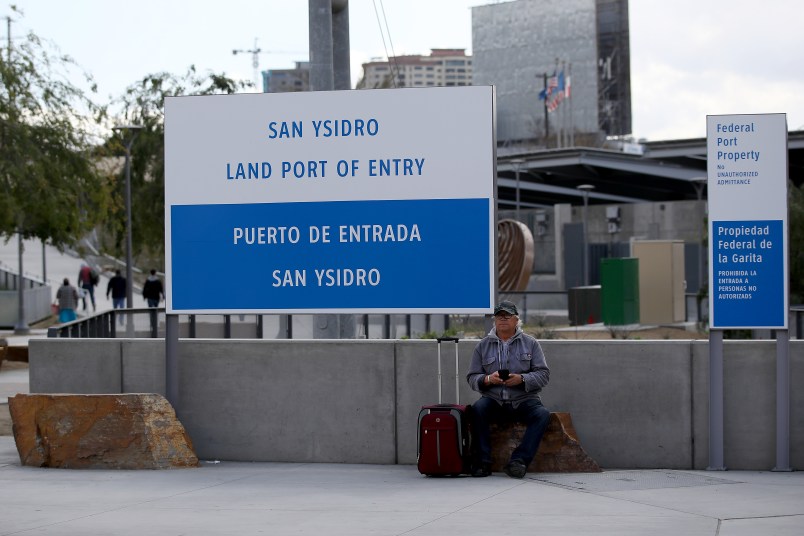President Donald Trump’s Twitter pledge on Monday to “temporarily suspend” all immigration to the United States was finally translated into a legal document Wednesday night — one with plenty of caveats that didn’t fit into 280-character missives.
The temporary suspension, which affects visa applicants not currently in the U.S., will last 60 days unless it is renewed.
And though there are plenty of exceptions in the document, it also affects tens of thousands of people. If it is extended beyond its initial two months, the suspension will be a significant step forward for Trump and his close adviser Stephen Miller’s effort to dramatically restrict legal immigration into the U.S.
The immigration law-focused start-up Boundless found that, if applied to the 1.1 million green cards typically issued in the U.S. every year, the rules in Trump’s Thursday suspension would block more than 350,000 of them. The group also found that the order would favor migrants from western Europe, Canada and Australia.
“To put it another way, Trump’s new immigration ban looks suspiciously like his plan for transforming the U.S. immigration process into a merit-based system,” wrote Aaron Rechlin-Melnick, policy counsel at the American Immigration Council.
The parents, adult children and siblings of citizens applying for entry to the U.S. from overseas will be blocked from entering, for now, as a result of Trump’s order. So will the relatives of lawful permanent residents. And would-be immigrants who lucked out in the Diversity Visa lottery will have to wait to cash in their tickets. The Trump administration has targeted these groups of would-be migrants in the past.
Rather than focusing on public health implications of travel and immigration, the White House has pitched the order as a way to “put unemployed Americans first” amid historic job losses, the result of COVID-19 “stay-at-home” orders across the country. But immigration lawyers and advocates see a political ploy.
“This is just an effort by the administration to distract from its inability to effectively manage the COVID-19 crisis,” Shev Dalal-Dheini, director of government relations for the American Immigration Lawyers Association, told TPM Thursday.
“Rather than acknowledging its own failures and its own ability to control peoples’ actions, it took its normal course, targeting its favorite victims.”
But the executive order also includes several exceptions, most notably for the spouses and minor children of American citizens, people overseas who had already obtained visas, and those applying for an adjustment of their status who are already in the U.S. It also will not apply to health care workers seeking to fight COVID-19 in the U.S., nor military personnel or wealthy entrepreneurs promising to create jobs.
And it allows entry to those seeking temporary visas, such as farm workers and students — though the order stipulates that the status of these “non-immigrant visas” applications could be reconsidered after a month to “ensure the prioritization, hiring, and employment of U.S. workers.” Dalal-Dheini called that language “a warning.”
“We are waiting on bated breath to see what’s going to happen there,” she said.
That exemption for temporary workers reflects a behind-the-scenes lobbying effort from sectors that rely on immigrants’ labor, like the tech and agriculture industries. In The New York Times’ words Wednesday, business groups “exploded in anger” at the prospect of losing guest workers.
In the midst of the COVID-19 crisis, immigration has slowed substantially already. Given the exemptions and the closures of offices overseas due to COVID-19 — not to mention existing travel restrictions — the order was as much a political document as a legal one, some attorneys noted.
“In practice, this is just red meat for Trump’s base,” immigration attorney Nicolette Glazer observed. “Consular processing is suspended right now and even after they re-open, the time to boot up the bureaucratic machine it is highly unlikely that many applicants are going to be actually affected greatly by 21 June.”
But Dalal-Dheini and others acknowledged that the true impact of the executive order can only be measured after 60 days. The administration could choose to extend the restrictions, effectively decreasing legal immigration for much of the rest of Trump’s time in office.
“If this proclamation isn’t lifted in 60 days, the impacts could be dire,” Dalal-Dheini said. After that point, what was pitched as a two-month freeze could effectively bar tens of thousands of visa applicants including the family members of citizens and legal permanent residents.
And even if the order is lifted on time, the piles of paperwork currently stacking up at embassies and consular offices around the country could take months to sort through.
Diversity Visa lottery “winners,” for example, have to have their visas processed by the end of the fiscal year — Sept. 30. Without their visas stamped by then, Glazer wrote, “they are out forever.”
For now, as COVID-19 has nearly ground international travel to a halt and closed U.S. government offices around the world, Trump’s order adds yet another brick to what Dalal-Dheini called the “invisible wall.”
“The issue is, we don’t know what the true impact of this proclamation will be,” she said.







Melanoma gives her $0.02:
Governance by randomly pushing and pulling levers with no underlying sensible and productive policy goals results in Trump’s usual chaos and deflection. I give him a big, fat “F.”
Racists gotta’ race.
Trump does what he always does when faced with charges of negligence and incompetence, distract by punching downward. Immigrants see what’s happening in America, and are probably cool with waiting until January, 2021, to come here.
Has anyone in the media asked him about this obscenity?
previously
https://thehill.com/homenews/house/288541-hispanic-caucus-chairman-denounces-trumps-bigoted-immigration-message